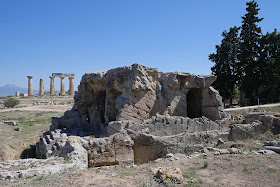The Fountain of Glauke
We are en route from Athens to Nafplio, but breaking our journey to see Ancient Corinth. Corinth was was one of the great Greek city states, but was entirely destroyed by the Romans in 146 BC and rebuilt by Julius Caesar from 44 BC. Most of what is now visible dates from the 1st to the 3rd century AD.
The first thing you see on entering the main site is the Fountain of Glauke (above). The celebrated Roman traveller Pausanias wrote in AD 150 that the fountain received its name from Glauke, daughter of Creon, the King of Corinth, and the second wife of the hero Jason (he of the Argonauts). Medea, Jason’s first wife, in a fit of jealousy presented Glauke with a cloak infused with poison. After putting on the cloak, Glauke threw herself into the fountain in an unsuccessful attempt to stop the poison from burning her. [Information from the American School of Classical Studies website]
It soon became apparent that there were a few butterflies in view as well, including this beautiful Painted Lady and several Swallowtails and Whites.
We decided to look in the Museum before exploring the rest of the site and this proved to be a great idea, with lots of good statues and two fabulous Roman mosaics.
Round the back of the Museum was this striking group of short columns with lintels over Corinthian capitals.
The main event however was the Temple of Apollo, one of the oldest Temples in Greece, dating back to about 550 BC. It dominates the site, standing as it does on a knoll which is the highest point.
The temple was built in the Doric style. It had 6 columns at each
end, and 15 along each side. It was 53m (174 feet) long and 21m (70
feet) wide. The columns are monolithic, that is, made from single pieces of stone and display obvious entasis (swelling).Beyond the temple is the vast Agora (Roman forum) which includes the platform where St Paul preached to the Corinthians.
On the far side is the Fountain of Peirene. The actual fountain is hidden behind a facade which once had six columns, but it still provides water for the nearby village.
Finally there is a short stretch of Roman Road, the Lechaion Road, which led to Lecheo, one of Corinth's two ports.
There is one interesting building outside the main site: the ruins of the Roman Odeon.
In the background, on the mountain to the left is the great fortress of Acrocorinth, strategically placed to defend the Isthmus of Corinth. It was originally a Greek acropolis, but later became a Roman citadel and then a Byzantine fortress. The Franks captured it in 1210 and later occupants included the Kingdom of Naples, the Knights of Rhodes, the Turks and the Venetians. We decided we did not have time to see it, but driving south later on, it was obviously what massive fortifications remained.
Conditions: hot and sunny.
Rating: four and a half stars.










No comments:
Post a Comment